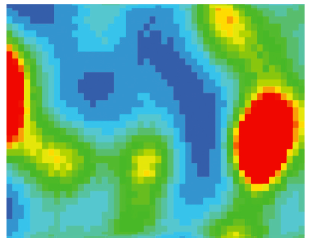
Published 2019-06-30
Keywords
- Water injection,
- Completions wells,
- Injector wells,
- Productor wells,
- water front
How to Cite
Abstract
Currently, the water injection into mature fields (Campo Parahuacu-Ecuador) is generally used to maintain pressures and increase the sweep of oil banks through secondary recovery projects. Due to the difference of mobilities of the fluids during the displacement, viscous interdigitations are formed due to the anisotropic behavior of the permeabilities in the production formation. In the present investigation the use of inflow control devices (ICD), orifice type, in the completions implemented in a water injector well to decrease the effect of the viscous fingers, improving the sweep efficiency in the reservoirs of Petroleum.
For the development of the simulations using ICD, a direct injection model was proposed between a producer well and an injector, using the Rubí software, and to model the behavior of the injection rate using ICD, the NETool software was used.
Through the use of the ICDs, all strata of different permeabilities were injected with the same rate to be able to reach a better profile of the water advance front and decrease the viscous interdigitation, increasing the recovery factor, which increased by 10% , during the application of the PRH-03B injector well to the PRH-13 well system according to the simulated data.
Downloads
References
Baby, P., Rivadeneira, M., & Barragán, R. (2004). La Cuenca Oriente Geología y Petróleo. Quito - Ecuador: Cámara Ecuatoriana del Libro - Núcleo de Pichincha.
Badr M. Al-Harbi, Saud A. BinAkresh, Abdulaziz A. Al-Ajaji, y Edgar J. Pinilla Forero (2010). Pressure Transient Analysis: Characterizing the Reservoir and Much More. Society of Petroleum Engineer.
Coral, L. (2012). Estudio para proyecto piloto de recuperación secundaria de petróleo por inyección de agua. Buenos Aires: UBA.
Coronado, M. P., Garcia, L., Russell, R., Garcia, G. A., & Peterson, E. R. (2009, January 1). New Inflow Control Device Reduces Fluid Viscosity Sensitivity and Maintains Erosion Resistance. Offshore Technology Conference. doi:10.4043/19811-MS
Cruz, H. D. O., Duque, J. P. V., & Marulanda, J. F. F. (2015). Propuesta metodológica para el control y monitoreo de un proceso de inyección de agua. Revista Fuentes, 13(2).
Garcia, G.A., et al., Identifying Well Completion Applications for Passive InflowControl Devices, in SPE Annual Technical Conference and Exhibition. 2009, Society of Petroleum Engineers: New Orleans, Louisiana.
Gavioli, P., et al. Evaluating Four Types of Passive Inflow Control Devices. in Passive Inflow Control Technology. 2008. Perth, Australia: Passive Inflow Control Technology.
Kotlar, N. (2015). Using ICD for production control and optimization. Buenos Aires: Kappa.
Kvernstuen, S., et al., ICD Screen Technology in Stag Field to Control Sand andIncrease Recovery by Avoiding Wormhole Effect, in International PetroleumTechnology Conference. 2008, International Petroleum Technology Conference: KualaLumpur, Malaysia.
Landmark-Halliburton. (2014). Inflow Control Devices. Obtenido de http://www.halliburton.com/public/cps/contents/Data_Sheets/web/H/H010897.pdf
Lorgen, G., Answers to questions about Baker Hughes ICD equipment, H.-E. Torbergsen, Editor. 2010: Stavanger.
Mantilla, J. (2003). Cuantificación de la incertidumbre asociada en la predicción del comportamiento de producción de un yacimiento altamente heterogéneo sometido a inyección de agua. Fuentes: El reventón energético, 3(1), 6.
Moen, T. and Reslink A/S, ResFlowTM Erosion and Flow Test. 2006, Reslink. p. 20.
Molano, A. M. J., Navarro, S. F. M., & Díaz, R. J. (2014). Metodología para el diseño de baches en un proceso de inyección de polímeros para recobro mejorado, considerando fenómenos de interacción roca/fluidos. Fuentes: El reventón energético, 12(2), 6.
Navarro, S. F. M., & Meneses, Y. M. S. (2008). Generalidades de la formación, prevención y tratamiento de depósitos de escamas. Revista Fuentes, 6(1).
Olivier Houzé, Didier Viturat y Ole S. Fjaere. Dinamic Data Analysis. Francia: KAPPA (Ecrin v5.10.01., 2016).
Raffn, Hundnes, & Moen. (2007). ICD Screen Technology Used to Optimize Waterflooding in Injector Well. SPE.
Slayter, A. and Senergy, ICDs: the impact of fluid viscosity on their performance;DM# 681080. 2010.
Sætre, G., Oil Selector - A solution for complete reservoir management presentation to the SPE Stavanger Section, 2007.
Toro, G. M., Herrera, J. J., Orrego, J. A., Rojas, F. A., Rueda, M. F., & Manrique, E. J. (2018). Effect of ionic composition in water: oil interactions in adjusted brine chemistry waterflooding: preliminary results. Fuentes: El reventón energético, 16(2), 73-82.
Velandia, J. L. P. (2013). Simulación numérica del flujo bifásico agua-petróleo en un medio poroso. Fuentes: El reventón energético, 11(2), 10.